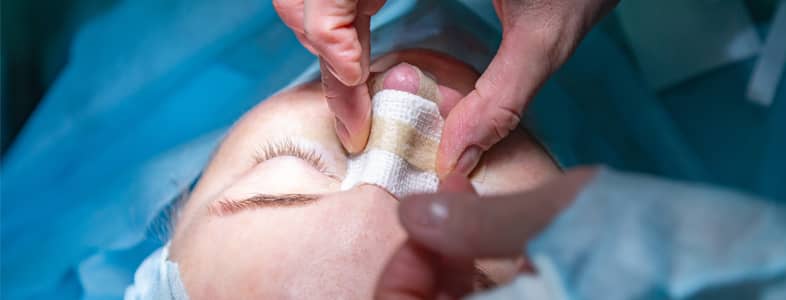
How Long Do Side Effects Last?
- Bruising: Bruising after rhinoplasty typically affects the area below each eye. The first signs of bruising may be visible immediately after surgery and last for one to two weeks. For most patients, the bruising begins to face by the seven to the 10-day mark. In rare cases, rhinoplasty bruising may last up to four weeks. Make-up can be applied to tone down the bruising in the second week after surgery.
- Swelling: Rhinoplasty patients typically experience swelling in the areas under the eyes and on the nose. Post-surgical swelling is the side effect that tends to last the longest after surgery. The swelling will be visible when you wake for surgery. It will be at its worst for the first two weeks after surgery. After that point, swelling may be difficult for others to notice, but it will still obscure the final result. By three months after surgery, about 75 percent of the swelling should be gone; all swelling could take as long as one year to go down.
- Pain: Patients tend to experience the most discomfort the day or two after surgery. Dr. Marin will recommend or prescribe medication to treat post-surgical pain. For most patients, the discomfort steadily declines as the days pass. A week or two after surgery, the pain is tolerable and may even be gone. Patients may experience some tenderness for a month after surgery.
- Numbness: It is usual for patients to experience some numbness after rhinoplasty surgery. This effect may linger for a year or two after surgery.
- Internal and External Nasal Splints: Dr. Marin may place internal splints, along with an external nasal splint during your rhinoplasty procedure. The splints are used to help the nose maintain its new shape and protect it from injury. About one week after surgery, Dr. Marin will have you return to our practice so the splints can be removed.
- Stitches: Patients typically have their stitches removed, if any are required, at the same time the nasal splints are removed, about seven days after surgery.
Adjusting Your Lifestyle Habits
- Rest: It is essential to rest for at least a few days after rhinoplasty surgery to give your body adequate time to recover.
- Work: Patients should expect to take seven to 10 days off of work, during which time they should have visible bruising and swelling, in addition to stitches and nasal splints.
- Exercise: While it is a good idea to take brief walks throughout the day in a week or two after surgery, rhinoplasty patients should not overexert themselves or engage in activities that could raise blood pressure. Higher blood pressure can result in scar tissue, which could affect the results of surgery. Avoid strenuous activity and moderate to heavy exercise for about six weeks after surgery.
- Blowing the Nose: Patients should refrain from blowing the nose for about three weeks after surgery.
- Make-up: It is essential to keep the splints and incision sites clean and free of bacteria and toxins. Do not wear makeup for one week after surgery to reduce the risk of complications.
- Sun Exposure: Dr. Marin recommends that patients avoid excessive sun exposure and tanning for several months after surgery. If you are out in the sun, wear sunscreen.
Contact Marin Aesthetics today to schedule your rhinoplasty consultation with Dr. Marin.
*The content in this blog is developed to spread the awareness towards plastic surgery. Our blog is not intended to serve as a replacement for an actual in-office consultation with Dr. Marin. As such, the information within this blog reflects the unique cases of our individual patients.
Comments are closed here.